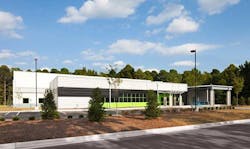Investing in the Edge: Funding Preps Compass for New Phase of Growth
Compass Datacenters was created to deploy data center capacity in new ways in new places. It will now be pursuing that plan with new investors.
Private equity firm Redbird Capital and the Ontario Teachers Pension Fund are the new investment team, with Compass founder and CEO Chris Crosby and the management team retaining an equity stake and continuing to head the company’s operations.
The deal highlights the growing investor interest in edge computing and new data center capacity to support the Internet of Things. Redbird is also an investor in Tierpoint, which like Compass has focused on building data centers in secondary markets across the U.S.
“The next major wave of growth in the data center industry will be driven by the need for dedicated data centers that address technology trends including large-scale Internet of Things deployments, edge computing strategies that reduce latency, rapid delivery of new applications, and more,” said Crosby.
Crosby says the new funding positions Compass to move more assertively to pursue those opportunities.
“We’re able to do some new things about getting land in new markets, and have the ability to invest in larger campuses,” he said. “I believe we’re uniquely positioned and there’s plenty of opportunity out there.”
Optimized for Edge and IoT
Compass was launched in 2012 to bring the wholesale data center product into new markets, looking beyond major tech hubs like Silicon Valley and northern Virginia. Early Compass projects have been built in markets like Nashville, Minneapolis and Durham. Its approach featured smaller data centers, each offering about 1.2 megawatts of IT capacity. Each building is dedicated to a single customer, but offering a menu of options to address different requirements.
This approach allows Compass to standardize its design, using pre-fabricated components to control cost and speed to market, while acknowledging that no two customers are alike. It describes the design choices as “personalization, not customization.” Compass pursues a campus strategy, enabling customers to easily expand in phases to add additional capacity at a site as demand dicatets.
Crosby is known as an innovator in data center design and business models. At Digital Realty, he helped create and popularize the wholesale data center model, allowing customers to lease dedicated data center suites instead of cages and cabinets. At a time when much of the industry was focused on building huge data centers in major market, he chose a different path when he started Compass.
The Compass model has proven popular with service providers. Its customers include Windstream, Iron Mountain and CenturyLink.
“If anything, we were a little early with our story,” said Crosby. “We have a solution that isn’t all things to all people. Edge has always been a bit of a head scratcher. Now we’re definitely seeing demand for it.”
The Opportunity in Secondary Markets
Redbird Capital is a believer in the market for second-tier and edge data center capacity. In 2014 it participated in the acquisition of Tierpoint, which has pursued an aggressive expansion in secondary markets, primarily through the acquisition of local and regional providers.
“Compass’s unique solutions align perfectly with the way data center needs are evolving for large cloud/SaaS providers, corporate customers and service providers, and this investment gives Compass significant resources to take advantage of market opportunities,” said Robert Covington, Partner of RedBird Capital. “Compass now has the ability to develop larger, multi-phase projects for customers, as well as to invest in the acquisition of real estate in markets that support customer needs.”
“We have an expertise in land development,” said Crosby. “We have no problem with being a provider’s provider.”
Last year Compass updated its design to offer slightly larger facilities, with an eye toward working with cloud service providers, which tend to provision capacity in larger chunks. One of the more intriguing opportunities for Compass is the market for “availability zones” for cloud providers, offering redundancy and footprints in new markets as well as expansion capacity in some major markets.
An example: its next data center is being built in the Dallas market, one of the busiest and most competitive data center markets.
“I’m very excited,” said Crosby. “We really believe we can make a difference out there.”






